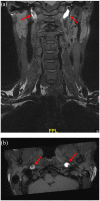Cervical and intracranial artery dissections
- PMID: 34408787
- PMCID: PMC8366117
- DOI: 10.1177/17562864211037238
Cervical and intracranial artery dissections
Abstract
This review summarizes recent therapeutic advances in cervical (CeAD) and intracranial artery dissection (IAD) research. Despite unproven benefits, but in the absence of any signal of harm, in patients, with acute ischemic stroke attributable to CeAD, intravenous thrombolysis and, in case of large-vessel occlusion, endovascular revascularization should be considered. Future research will clarify which patients benefit most from either treatment modality. For stroke prevention, the recently published randomized controlled TREAT-CAD study showed that, against the initial hypothesis, aspirin was not shown non-inferior to anticoagulation with vitamin K antagonists (VKAs). With the results of two randomized controlled trials (CADISS and TREAT-CAD) available now, the evidence to consider aspirin as the standard therapy of CeAD is weak. Further analyses might clarify whether the assumption supports, in particular, that patients presenting with cerebral ischemia, clinical or subclinical with magnetic resonance imaging surrogates, might benefit most from VKA treatment. In turn, it remains to be shown, whether in CeAD patients presenting with pure local symptoms and without hemodynamic compromise, antiplatelets are sufficient, and whether a dual antiplatelet therapy during the first weeks of treatment is recommendable. The observation that ischemic strokes occurred (or recurred) very early after CeAD diagnosis, consistently across randomized and observational studies, supports the recommendation to start antithrombotic treatment immediately, whatever antithrombotic agent is chosen in each individual case. The lack of a license for the use in CeAD patients and the paucity of data are still arguments against the use of direct oral anticoagulants in CeAD. Nevertheless, due to their beneficial safety and efficacy profile proven in atrial fibrillation, these agents are a worthwhile treatment option to be tested in further CeAD treatment trials. In IAD, the experience with the use of antithrombotic agents is limited. As the risk of suffering intracranial hemorrhage is higher in IAD than in CeAD, the use of antithrombotic therapy in IAD remains controversial.
Keywords: cervical artery dissection; intracranial dissection; stroke; stroke-therapy.
© The Author(s), 2021.
Conflict of interest statement
Conflict of interest statement: STE reports grants from the Swiss National Science Foundation, Swiss Heart Foundation, the Freiwillige Akademische Gesellschaft Basel, the University of Basel, the University Hospital Basel, outside of the submitted work. PL reports grants from Bayer GmbH Germany, Swiss National Science Foundation, ProPatient Foundation of the University Hospital Basel, travel grants from Bayer AG Switzerland, Pfizer AG Switzerland, advisory board compensation from Bayer AG Switzerland, Pfizer AG Switzerland, Daiichi Sankyo Switzerland, Bristol Myers Squibb Switzerland, Recordati SA Switzerland, Amgen Switzerland, and compensation for research activities from Sanofi Switzerland and Acticor SA France, all outside of the submitted work. CT reports grants from the Swiss Heart Foundation, the University of Basel, the Bangerter-Rhyner Foundation and the Freiwillige Akademische Gesellschaft Basel and travel honoraria from Bayer AG, all outside of the submitted work.
Figures



References
-
- Debette S, Leys D.Cervical-artery dissections: predisposing factors, diagnosis, and outcome. Lancet Neurol 2009; 8: 668–678. - PubMed
-
- Engelter ST, Traenka C, Lyrer P.Dissection of cervical and cerebral arteries. Curr Neurol Neurosci Rep 2017; 17: 59. - PubMed
-
- Debette S, Compter A, Labeyrie MA, et al.. Epidemiology, pathophysiology, diagnosis, and management of intracranial artery dissection. Lancet Neurol 2015; 14: 640–654. - PubMed
-
- Bejot Y, Daubail B, Debette S, et al.. Incidence and outcome of cerebrovascular events related to cervical artery dissection: the Dijon stroke registry. Int J Stroke 2014; 9: 879–882. - PubMed
-
- Debette S.Pathophysiology and risk factors of cervical artery dissection: what have we learnt from large hospital-based cohorts? Curr Opin Neurol 2014; 27: 20–28. - PubMed
Publication types
LinkOut - more resources
Full Text Sources
Research Materials
Miscellaneous

